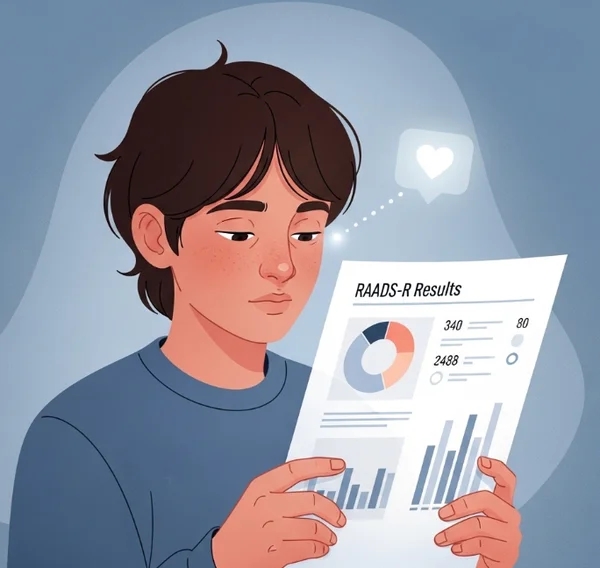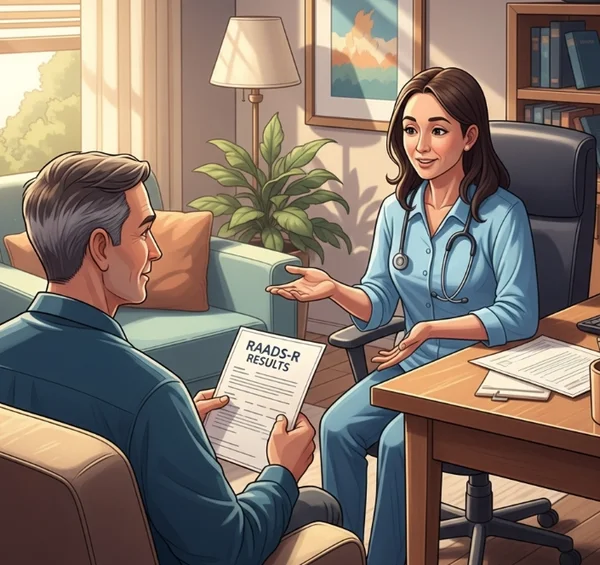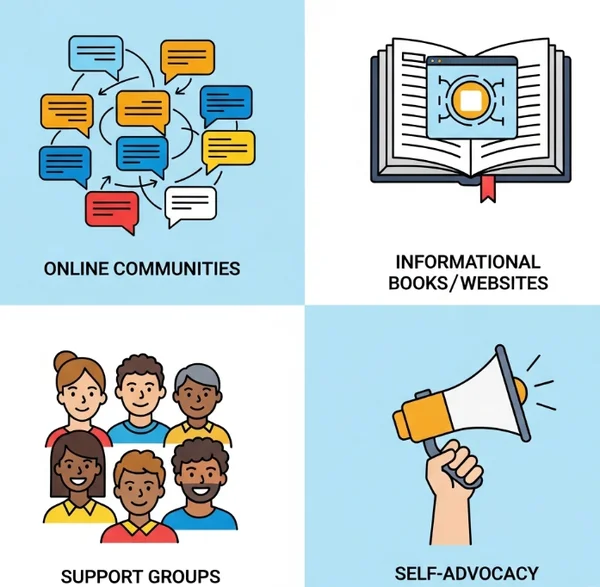After RAADS-R Test: Next Steps & Support Guide
June 5, 2025 | By Elara Vance
You've completed the RAADS-R test, and now you have your results. This is an important moment in your journey of self-discovery. But what should i do after taking the raads-r test? Many people feel a mix of emotions – curiosity, relief, confusion, or perhaps validation. Understanding your RAADS-R test results is the first step, but knowing what to do next is equally crucial. This guide from raads-r.net will walk you through interpreting your score, practical next steps for self-reflection, when to seek professional advice, and how to find appropriate RAADS-R support.
First Things First: Understanding Your RAADS-R Score & Its Limits
Before diving into action, it's vital to correctly frame your understanding of your RAADS-R score. This initial understanding sets the stage for all subsequent steps.
What the RAADS-R Test Measures (and What It Doesn't)
The RAADS-R test is a self-report questionnaire designed to identify adult autistic traits across several domains: social relatedness, language, sensory-motor experiences, and circumscribed interests. It measures the extent to which you endorse these traits based on your lifelong experiences. What it doesn't do is provide a formal medical diagnosis of Autism Spectrum Disorder (ASD) or any other condition. It's a valuable screening tool, not a diagnostic conclusion.
It's a Screening Tool, Not a Diagnosis: Managing Expectations
This is perhaps the most critical point. Is the raads-r test enough for a diagnosis? No. A high score on the RAADS-R suggests that your reported traits are consistent with those often found in autistic individuals and may warrant further investigation. A low score suggests fewer such traits. However, only a qualified healthcare professional can provide an actual diagnosis after a comprehensive professional autism assessment. It's important to manage your expectations accordingly.
Acknowledging Your Emotional Response to the Results
Receiving any test result, especially one related to neurodiversity, can evoke a range of feelings. You might feel validated if the results align with your suspicions, or confused if they don't. Some might feel anxious about what a high score means, while others might feel relief. Allow yourself to process your emotional response without judgment. This is a normal part of the autism self-assessment next steps.

Step 1 After RAADS-R Test: Self-Reflection and Observation
Once you've acknowledged the nature of the RAADS-R test and your initial feelings, the first practical step after your RAADS-R test is deeper self-engagement.
Connecting Your Score to Your Lived Experiences
Your RAADS-R score is a number, but your lived experiences are rich and complex. Think about the specific questions you endorsed. How do these relate to challenges or unique ways of experiencing the world in your daily life – at work, in relationships, or in sensory environments? This self-reflection is key to personalizing the meaning of your score.
Journaling and Noting Patterns: Practical Self-Assessment Next Steps
Consider journaling about specific situations that come to mind as you review your RAADS-R responses. Are there recurring patterns in your social interactions, communication style, sensory sensitivities, or interests? Noting these down can provide valuable insights and prepare you for potential discussions with professionals. This is a constructive part of autism self-assessment next steps.
Consider Using Our AI Personalized Analysis for Deeper Insights
To aid your self-reflection, raads-r.net offers an optional AI Personalized Analysis after you complete the RAADS-R test. This feature can provide more nuanced interpretations by considering your responses in a broader context, potentially highlighting strengths, challenges, and areas for further exploration beyond the raw score. It's another tool to help you in interpreting your score and experiences.

Step 2: When and How to Seek Professional Autism Assessment
If your RAADS-R score is elevated, or if your self-reflection identifies significant ongoing challenges, seeking a professional autism assessment is a logical next step. My raads-r score is high, what now?
Indicators That Suggest a Formal Evaluation is Warranted
Several indicators might suggest that a formal evaluation is a good idea:
- A consistently high RAADS-R score (e.g., well above the common research threshold of 65).
- Reported traits significantly impacting your daily functioning, work, relationships, or mental well-being.
- A strong, persistent feeling that an autism diagnosis would provide clarity, validation, or access to needed support and accommodations.
- Co-occurring mental health concerns that might be related to or exacerbated by undiagnosed autistic traits.
Finding Qualified Professionals: Psychologists, Psychiatrists, and Specialists
When seeking a diagnosis, it's important to find qualified professionals experienced in assessing autism in adults. This might include:
- Psychologists (often Clinical Psychologists or Neuropsychologists)
- Psychiatrists
- Specialized autism assessment clinics or centers. Look for professionals who explicitly state they diagnose adults and are familiar with the nuances of adult presentation, including masking.
Preparing for Your Consultation: What to Bring (Including RAADS-R Results)
Good preparation for your consultation can make the process smoother. Consider bringing:
-
Your RAADS-R test results from raads-r.net (the numerical score and perhaps notes on specific responses).
-
Any journal entries or observations you've made.
-
A list of your specific concerns and questions.
-
If comfortable, and if the professional requests it, information from a close family member about your early development (though this is not always required or possible for adults). This information helps build a comprehensive picture for the diagnostic process.

Step 3: Exploring Autism Support Resources and Communities
Regardless of whether you pursue a formal diagnosis immediately, or what your score is, exploring RAADS-R support and broader autism support resources can be beneficial. Where can i get help after an autism screening?
Online Support Groups and Neurodiversity Communities
Many vibrant online support groups and neurodiversity communities exist (e.g., on platforms like Reddit, Facebook, or dedicated forums). These can offer peer support, shared experiences, and a sense of belonging. Connecting with others who have similar lived experiences can be incredibly validating.
Reputable Websites and Organizations for Autism Information
Seek out reputable websites and organizations for accurate information about autism in adults. Sources like the Autistic Self Advocacy Network (ASAN), national autism societies (e.g., Autism Society of America), and governmental health institutes (like NIMH, CDC) provide reliable online resources.
Understanding Potential Accommodations and Self-Advocacy
Learning about potential accommodations in work or education, and developing self-advocacy skills, can be empowering. Understanding your needs allows you to communicate them more effectively and seek environments that are more supportive of your neurotype. This is a key aspect of neurodiversity acceptance.

What if My RAADS-R Score is Low or In the Middle?
Not everyone who takes the RAADS-R test will have a high score. What if my RAADS-R score is low but I still feel different?
Interpreting Lower Scores: It's Still Valuable Information
Even if your score is below the common threshold, the process of taking the test and reflecting on the questions can still provide valuable information. It might highlight specific areas where you experience challenges, even if they don't align strongly with a typical autistic profile according to this specific screening tool. The RAADS-R is just one lens.
Continuing Self-Exploration Regardless of the Score
Your journey of self-exploration doesn't have to end with a single test score. If you continue to have questions or concerns about your experiences, sensory sensitivities, or social interactions, continue to learn and observe. Other factors or conditions might be at play, or you might simply have a unique neurocognitive style that doesn't fit neatly into current labels.

Your RAADS-R Results: A Compass for Your Journey
Your RAADS-R test results are best viewed as a compass, offering direction and insight, rather than a final destination. Whether your score is high, low, or somewhere in between, it provides an opportunity for deeper self-understanding and informed choices about your autism self-assessment next steps. Use this information from raads-r.net to navigate your path forward, whether that involves further professional consultation, seeking community support, or simply enriching your self-awareness.
What are your biggest questions or takeaways after receiving your RAADS-R results? Share your thoughts or experiences in the comments below – your journey might resonate with others!
Navigating Life After Your RAADS-R Test
-
My RAADS-R score is high, does this mean I am definitely autistic?
No, a high RAADS-R score (e.g., above 65) suggests that you report many traits consistent with Autism Spectrum Disorder. However, the RAADS-R test is a screening tool, not a diagnostic instrument. A formal diagnosis can only be made by a qualified healthcare professional after a comprehensive professional autism assessment.
-
What should I tell a doctor about my RAADS-R test results?
You can share your score and any specific responses or patterns you noticed during your self-reflection. Explain why you took the test and what concerns you have. Your RAADS-R test results can be a helpful starting point for discussion during a professional consultation.
-
Are there specific support groups for adults who score high on the RAADS-R?
While there might not be groups specifically for "high RAADS-R scorers," there are many support groups (both online and offline) for autistic adults and adults exploring a potential autism diagnosis. These communities can provide peer RAADS-R support and shared understanding.
-
What if my RAADS-R score is low but I still feel different?
It's important to validate your feelings. A low score on the RAADS-R means you didn't endorse many traits specifically measured by this tool in a way that aligns with a typical autistic profile. However, there could be other reasons for feeling different (other neurodivergent traits, different conditions, unique personality, etc.). Continue your self-exploration and consider discussing your feelings with a trusted professional if they cause distress.
-
How can the AI Personalized Analysis on raads-r.net help me after the test?
The optional AI Personalized Analysis on raads-r.net aims to provide a more nuanced interpretation of your RAADS-R test results. By considering your responses (and any optional supplemental information you provide), it can offer insights into potential strengths, challenges, daily life impacts, and even suggest areas for an action plan, going beyond just the numerical score to enhance your understanding of your RAADS-R score.